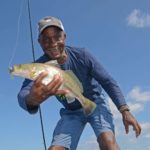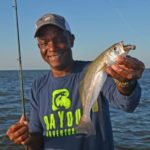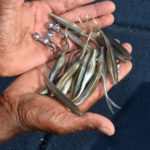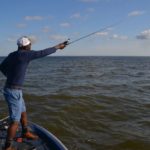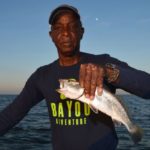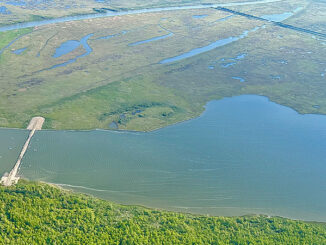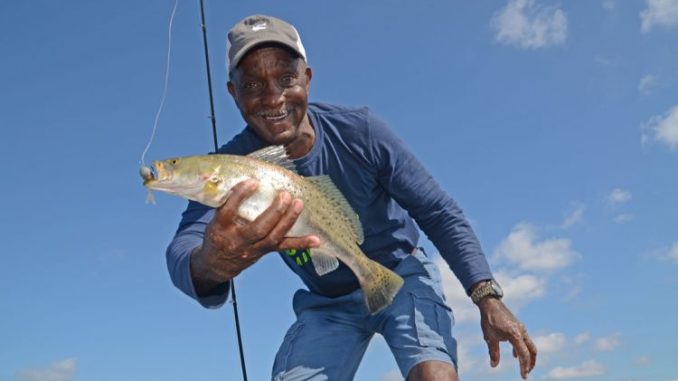
The window for crazy speckled trout action out of Lacombe is only about four weeks, but you don’t want to miss it. And this die-hard angler shares all you need to know to load the boat.
It’s spring, and what Forrest Green calls the “mother lode” of speckled trout is here.
And it won’t last forever.
“It’s at its peak from April 15 to May 15 each year,” Green cautioned.
Then they are gone.
We had to go, even if Shannon Griffin, who arranged the trip couldn’t make it.
“It’s like salmon,” Green explained. “We just wait and wait. When they run, we’re like the grizzly bears: We just ketch ’em and ketch ’em.
“It’s really good. You can catch 25 trout in 25 casts.”
The owner of Bayou Adventure in Lacombe described the man who she half-differentially, half-familiarly called “Mr. Green,” as a “dear friend” and a “great fisherman.”
“He comes by the store every day,” she said. “A day without Green is a day without sunshine. He’s been fishing competitively for 60 years and keeping his secrets to himself.
“Now he feels it’s time to share them.”
As for Green, he’s just happy to have a tackle store in town. “Before them, we had no tackle shop in Lacombe,” he said. “After they opened, I waited a few days, and then went and introduced myself. ‘I’m here to help you with whatever you need,’ I said. We have been close friends ever since.”
The public boat launch is just a short hop down Lake Road toward Lake Pontchartrain from the store.
While he readied the boat for launching I asked him how he picked up the moniker “Mr. Green.”
It turns out that he worked as a maintenance man and janitor at Bayou Lacombe Middle School for 30 years. Everybody at school called him Mr. Green.
“People in Lacombe stay in Lacombe,” he said. “As the kids grew up and became adults in Lacombe, they still called me Mr. Green.”
The name stuck and still does, even 10 years after retiring.
Green’s 19-foot fiberglass bass boat felt like more than enough boat while he tore down Bayou Lacombe toward Lake Pontchartrain, but after breaking out into the big water, it didn’t seem quite so substantial.
The wind appeared relatively light just after daylight, but the lake was already choppy enough to make for a bumpy and wet ride.
“The thing that gets us is the wind,” Green said by way of acknowledging the bounce. The number of days that Lake Pontchartrain isn’t rough ….”
He looked at me and grinned.
“Sometimes I have to prop myself up to fish, but the fish will be there,” he said.
Green was headed to one of the “rigs,” a superficially misleading word, since rigs no longer exist on any of the three locations. The three gas wells that occupied the spots were removed when the natural gas played out.
But the dense shell pads on which the drilling barges were situated remain and continue to attract fish.
In addition to the three shell pads, an artificial reef constructed of large reef balls has been placed in the lake out of Lacombe.
Green doesn’t like to fish the artificial reef because it is too easy to lose anchors to its rough structure.
“It holds plenty of fish, especially the last 3 years,” he admitted. “The good thing is that it keeps other fishermen off the old (shell pad) reefs.”
Green homed in his boat on a cluster of pilings that gave away the shell pad like a beacon. The other reefs he finds with his GPS, the coordinates of which are printed on the Lake Pontchartrain Basin Foundation’s fishing map.
By his expert eye, he knew without hesitation exactly where to anchor to cast onto the reef.
And cast he did, making Olympian hurls, one after the other
While he wasted no time between casts, his retrieves were slow, with twitches and bounces to keep the lure tending the bottom.
“All I use is plastic,” Green said.
But his choice of plastics is odd for saltwater — Zoom Super Fluke Juniors, usually thought of as largemouth bass baits.
“We were out here one day, and (the fish) were slow,” Green explained. “I had some Zoom Super Flukes on the boat because I’m a bass fisherman. I started switching baits, and all of a sudden I started getting bites.
“I went back to plastic cocahoes and they wouldn’t bite them. (Flukes are) all I use now.”
His favorite colors are Arkansas shiner and rainbow shad.
He is particular about his jigheads too, using only 3/8-ounce Goldeneye heads made by Dockside Tackle.
Of course, Mr. Green being Mr. Green, he does have a trick: He bites off the end of the head of each bait before threading it on the hook.
It straightens on the hook easier and rests against the jighead better, he claimed.
He picked up speckled trout at a steady, if not ferocious, pace. Mixed into the catch was the occasional white trout, which he rated as “not that different to eat than a speck.”
Only one other boat was on the reef that day, but it isn’t always like that.
“During the peak (of the run), 10 or 12 boats will be on each reef,” Green said. “But not everyone is catching — tempers go to flying. ‘You got my line. Your boat is too close. You don’t own the lake.’”
Compounding the crowding, he said, is the fact that most people use live bait, a much slower form of fishing.
Green noted with a sly grin that fishing isn’t over on the reefs when the “mother lode” of speckled trout plays out.
“I catch plenty of 15- to 20-inch black drum for a couple of weeks after the speckled trout are gone,” he said. “They bite plastics just as good as speckled trout.”
But on this day, he was a happy man with little competition for the fish.
“Lacombe is a paradise,” Green mused. “There ain’t no Lake Road anywhere else. If there was, I might move there. What makes us unique compared to Slidell or Mandeville is our native people are still here.
“Everybody knows everybody. The other places are full of people from somewhere else.”
